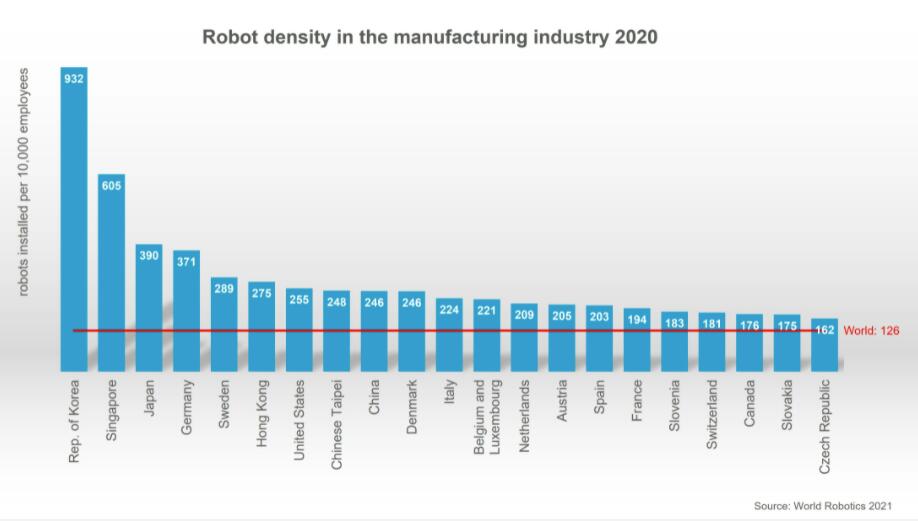全球機器人密度幾乎翻倍
http://www.kblhh.cn 2022-01-08 11:39 《中華工控網(wǎng)》翻譯
Robot Density nearly Doubled globally
全球機器人密度幾乎翻倍
The use of industrial robots in factories around the world is accelerating at a high rate: 126 robots per 10,000 employees is the new average of global robot density in the manufacturing industries – nearly double the number five years ago (2015: 66 units). This is according to the 2021 World Robot Report.
根據(jù)《2021年世界機器人報告》的數(shù)據(jù),世界各地工廠對工業(yè)機器人的使用正在高速發(fā)展,每萬名員工擁有126臺機器人是制造業(yè)中全球機器人密度的最新平均值--幾乎是五年前的兩倍(2015年:66臺)。
By regions, the average robot density in Asia/Australia is 134 units, in Europe 123 units and in the Americas 111 units. The top 5 most automated countries in the world are: South Korea, Singapore, Japan, Germany, and Sweden.
按地區(qū)劃分,亞洲/澳大利亞的平均機器人密度為134臺,歐洲為123臺,美洲為111臺。世界上自動化程度最高的前5個國家是。韓國、新加坡、日本、德國和瑞典。
“Robot density is the barometer to track the degree of automation adoption in the manufacturing industry around the world,” says Milton Guerry, President of the International Federation of Robotics.
國際機器人聯(lián)合會主席Milton Guerry說:“機器人密度是跟蹤世界各地制造業(yè)自動化采用程度的晴雨表。”

Asia
亞洲
The development of robot density in China is the most dynamic worldwide: Due to the significant growth of robot installations, the density rate rose from 49 units in 2015 to 246 units in 2020. Today, China’s robot density ranks 9th globally compared to 25th just five years ago.
中國的機器人密度發(fā)展是全世界最活躍的。由于機器人安裝量的大幅增長,密度率從2015年的49臺上升到2020年的246臺。今天,中國的機器人密度在全球排名第9位,而五年前僅為第25位。
Asia is also the home of the country with the world´s highest robot density in the manufacturing industry: the Republic of Korea has held this position since 2010. The country’s robot density exceeds the global average seven-fold (932 units per 10,000 workers). Robot density had been increasing by 10% on average each year since 2015. With its globally recognized electronics industry and a distinct automotive industry, the Korean economy is based on the two largest areas for industrial robots.
亞洲也是世界上制造業(yè)機器人密度最高的國家的所在地:韓國自2010年以來一直保持領先地位。該國的機器人密度超過了全球平均水平的7倍(每萬名工人932臺)。自2015年以來,機器人密度平均每年增加10%。憑借其全球公認的電子工業(yè)和獨特的汽車工業(yè),韓國經(jīng)濟以工業(yè)機器人的兩個最大應用領域為基礎。
Singapore takes second place with a rate of 605 robots per 10,000 employees in 2020. Singapore’s robot density had been growing by 27% on average each year since 2015.
新加坡以2020年每萬名員工擁有605個機器人的比率位居第二。自2015年以來,新加坡的機器人密度平均每年增長27%。
Japan ranked third in the world: In 2020, 390 robots were installed per 10,000 employees in the manufacturing industry. Japan is the world´s predominant industrial robot manufacturer: The production capacity of Japanese suppliers reached 174,000 units in 2020. Today, Japan´s manufacturers deliver 45% of the global robot supply.
日本位居世界第三。2020年,在制造業(yè)中,每萬名員工安裝390臺機器人。日本是世界上最主要的工業(yè)機器人制造商。2020年,日本供應商的生產(chǎn)能力達到17.4萬臺。今天,日本的制造商提供了全球機器人供應的45%。
North America
北美
Robot density in the United States rose from 176 units in 2015 to 255 units in 2020. The country ranks seventh in the world – ahead of Chinese Taipei (248 units) and China (246 units). The modernization of domestic production facilities has boosted robot sales in the United States. The use of industrial robots also aids to achieve decarbonization targets e.g. in the cost-efficient production of solar panels and in the continued transition towards electric vehicles. Several car manufacturers have announced investments to further equip their factories for new electric drive car models or to increase capacity for battery production. These major projects will create demand for industrial robots in the next few years.
美國的機器人密度從2015年的176臺上升到2020年的255臺。美國在全球排名第七,超過了中華臺北(248臺)和中國(246臺)。國內(nèi)生產(chǎn)設施的現(xiàn)代化推動了美國的機器人銷售。工業(yè)機器人的使用也有助于實現(xiàn)脫碳目標,例如,在成本效益高的太陽能電池板生產(chǎn)和繼續(xù)向電動汽車過渡方面。一些汽車制造商已經(jīng)宣布投資,為新的電動汽車模型進一步裝備他們的工廠,或增加電池生產(chǎn)的能力。這些重大項目將在未來幾年創(chuàng)造對工業(yè)機器人的需求。
Europe
歐洲
Europe´s most automated country is Germany - ranking 4th worldwide with 371 units. The annual supply had a share of 33% of total robot sales in Europe 2020 - 38% of Europe’s operational stock is in Germany. The German robotics industry is recovering, mainly driven by strong overseas business rather than by the domestic or European market. Robot demand in Germany is expected to grow slowly, mainly supported by demand for low-cost robots in the general industries and outside traditional manufacturing.
歐洲自動化程度最高的國家是德國--以371臺排名全球第四。年供應量占歐洲2020年機器人總銷售量的33%--歐洲38%的運營庫存在德國。德國機器人行業(yè)正在復蘇,主要是由強大的海外業(yè)務驅動,而不是由國內(nèi)或歐洲市場驅動。德國的機器人需求預計將緩慢增長,主要由一般行業(yè)和傳統(tǒng)制造業(yè)以外的低成本機器人需求支撐。
France has a robot density of 194 units (ranking 16th in the world), which is well above the global average of 126 robots and relatively similar compared to other EU countries like Spain (203 units), Austria (205 units) or The Netherlands (209 units). EU members like Sweden (289 units), Denmark (246 units) or Italy (224 units), have a significantly higher degree of automation in the manufacturing segment.
法國的機器人密度為194臺(世界排名第16位),高于全球126臺的平均水平,與西班牙(203臺)、奧地利(205臺)或荷蘭(209臺)等其他歐盟國家相比則相對接近。像瑞典(289臺)、丹麥(246臺)或意大利(224臺)這樣的歐盟成員,在制造業(yè)領域的自動化程度明顯更高。
As the only G7 country – the UK has a robot density below the world average of 126 units with 101 units, ranking 24th. Five years ago, the UK´s robot density was 71 units. The exodus of foreign labor after Brexit increased the demand for robots in 2020. This situation is expected to prevail in near future, the modernization of the UK manufacturing industry will also be boosted by massive tax incentives, the “super-deduction”: From April 2021 until March 2023, companies can claim 130% of capital allowances as a tax relief for plant and machinery investments.
作為唯一的G7國家,英國的機器人密度低于世界平均水平的126臺,只有101臺,排名第24。五年前,英國的機器人密度為71臺。英國脫歐后,外國勞動力的外流增加了2020年對機器人的需求。這種情況預計將在不久的將來出現(xiàn),英國制造業(yè)的現(xiàn)代化也將受到大規(guī)模稅收優(yōu)惠政策的推動,即 "超級減免"。從2021年4月到2023年3月,公司可以申請130%的資本津貼作為工廠和機器投資的稅收減免。
相關新聞
- ? 多元場景下,中國工業(yè)機器人走出差異化 AI 路徑
- ? 四個月兩度“加油”,越疆再配股募資7.7億港元
- ? 小鵬新一代人形機器人IRON亮相:首推女性形態(tài),目標2026年規(guī)模量產(chǎn)
- ? ABB機器人韓晨:本土供應商超80%,“十五五”在華大有可為
- ? 科技巨頭再投500億瞄準這個賽道
- ? 全資子公司變更 美的“機器人”走上臺面
- ? 越疆機器人與浪潮云正式簽署全球戰(zhàn)略合作協(xié)議
- ? 利潤同比暴增232.35%,工業(yè)機器人企業(yè)2025三季度業(yè)績出爐!
- ? 第二屆工業(yè)自動化與機器人國際學術會議暨半導體與集成電路創(chuàng)新論壇成功舉辦
- ? 藍思科技與越疆機器人達成戰(zhàn)略合作并下達1000臺機器人采購訂單
編輯精選
- ? 東土科技連投三家核心企業(yè) 發(fā)力具身機器人領域
- ? 第七屆工業(yè)互聯(lián)網(wǎng)大賽在京正式啟動
- ? 珞石機器人沖刺港交所主板上市
- ? 9月RatingDog中國制造業(yè)PMI升至51.2,延續(xù)擴張態(tài)勢
- ? ABB與軟銀簽約擬出售機器人業(yè)務
- ? 全球工廠機器人需求十年翻番——國際機器人聯(lián)合會發(fā)布《2025年世界機器人報告》
- ? 2025年度綠色工廠推薦工作啟動
- ? 羅克韋爾自動化重磅推出 ControlLogix 5590 控制器,引領工控新時代
- ? 華為系公司賽力斯與字節(jié)合作具身智能,問界要開發(fā)人形機器人?
- ? 40.5萬億元工業(yè)增加值 工業(yè)家底更厚實
工控原創(chuàng)
- ? 十月工控領域重要資訊,一睹為快!
- ? 回顧 | 以技術干貨 + 落地案例,解鎖產(chǎn)業(yè)升級新路徑
- ? ABB報告:工業(yè)停機每小時損失高達50萬美元,知行鴻溝阻礙現(xiàn)代化更新
- ? ABB宣布以53.75億美元將機器人業(yè)務出售給軟銀
- ? 九月不容錯過的工控圈大事
- ? 當“軟件定義”與“價值鏈”相遇,未來工業(yè)走向何方?
- ? 西門子:以“一次正確”破局內(nèi)卷,讓工業(yè)AI真正落地
- ? “四大家族”“四小龍”齊聚,工博會機器人展的亮點都在這了!
- ? 2025工博會開幕,工業(yè)AI釋放創(chuàng)新潛力
- ? 繁易的戰(zhàn)略進擊:從HMI到PLC,走向全棧式自動化融合創(chuàng)新




